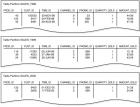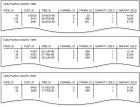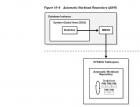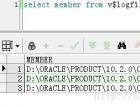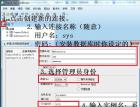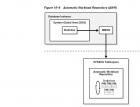OCP-1Z0-053-V13.02-631题
631.View the Exhibit and examine the output of the query in different times when the following command runs in an RMAN sessions:
RMAN> BACKUP DATABASE FILESPERSET 2;
The database has seven data files. Why is the %_COMPLETE refreshed to 13.59 in the third output after reaching 88.77?
Exhibit:
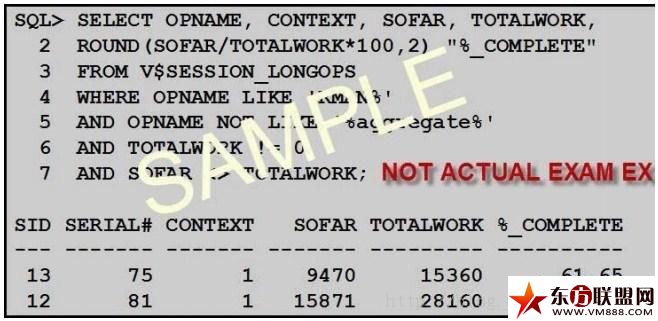
A. Because the progress is reported for each data file
B. Because the progress is reported for each backup set
C. Because other RMAN sessions have issued the same BACKUP command
D. Because new data files have been added to the database while the RMAN backup is in progress
Answer: B
答案解析:
参考:http://docs.oracle.com/cd/E11882_01/backup.112/e10642/rcmtunin.htm#BRADV89862
Monitoring RMAN Job Progress with V$SESSION_LONGOPS
You can monitor the progress of backups and restore jobs by querying the view V$SESSION_LONGOPS. RMAN uses two types of rows in V$SESSION_LONGOPS: detail rows and aggregate rows.
Detail rows describe the files being processed by one job step, whereas aggregate rows describe the files processed by all job steps in an RMAN command. A job step is the creation or restoration of one backup set or data file copy. Detail rows are updated with every buffer that is read or written during the backup step, so their granularity of update is small. Aggregate rows are updated when each job step completes, so their granularity of update is large.
Table 22-2 describes the columns in V$SESSION_LONGOPS that are most relevant for RMAN. Typically, you view the detail rows rather than the aggregate rows to determine the progress of each backup set.
Table 22-2 Columns of V$SESSION_LONGOPS Relevant for RMAN
| Column | Description for Detail Rows |
|---|---|
| SID | The server session ID corresponding to an RMAN channel |
| SERIAL# | The server session serial number. This value changes each time a server session is reused. |
| OPNAME | A text description of the row. Examples of details rows include RMAN: datafile copy, RMAN: full datafile backup, and RMAN: fulldatafile restore. Note: RMAN: aggregate input and RMAN: aggregate output are the only aggregate rows. |
| CONTEXT | For backup output rows, this value is 2. For all other rows except proxy copy (which does not update this column), the value is 1. |
| SOFAR | The meaning of this column depends on the type of operation described by this row: For image copies, the number of blocks that have been read For backup input rows, the number of blocks that have been read from the files being backed up For backup output rows, the number of blocks that have been written to the backup piece For restores, the number of blocks that have been processed to the files that are being restored in this one job step For proxy copies, the number of files that have been copied |
| TOTALWORK | The meaning of this column depends on the type of operation described by this row: For image copies, the total number of blocks in the file. For backup input rows, the total number of blocks to be read from all files processed in this job step. For backup output rows, the value is 0 because RMAN does not know how many blocks that it will write into any backup piece. For restores, the total number of blocks in all files restored in this job step. For proxy copies, the total number of files to be copied in this job step. |
Each server session performing a backup or restore job reports its progress compared to the total work required for a job step. For example, if you restore the database with two channels, and each channel has two backup sets to restore (a total of four sets), then each server session reports its progress through a single backup set. When a set is completely restored, RMAN begins reporting progress on the next set to restore.
To monitor RMAN job progress:
Before starting the RMAN job, create a script file (called, for this example, longops) containing the following SQL statement:
- SELECT SID, SERIAL#, CONTEXT, SOFAR, TOTALWORK, ROUND(SOFAR/TOTALWORK*100,2) "%_COMPLETE" FROM V$SESSION_LONGOPS WHERE OPNAME LIKE 'RMAN%' AND OPNAME NOT LIKE '%aggregate%' AND TOTALWORK != 0 AND SOFAR <> TOTALWORK;
Start RMAN and connect to the target database and recovery catalog (if used).
Start an RMAN job. For example, enter:
RMAN> RESTORE DATABASE;While the RMAN job is running, start SQL*Plus and connect to the target database, and execute the longops script to check the progress of the RMAN job. If you repeat the query while the RMAN job progresses, then you see output such as the following:
SQL> @longops SID SERIAL# CONTEXT SOFAR TOTALWORK %_COMPLETE ---------- ---------- ---------- ---------- ---------- ---------- 8 19 1 10377 36617 28.34 SQL> @longops SID SERIAL# CONTEXT SOFAR TOTALWORK % COMPLETE ---------- ---------- ---------- ---------- ---------- ---------- 8 19 1 21513 36617 58.75 SQL> @longops SID SERIAL# CONTEXT SOFAR TOTALWORK % COMPLETE ---------- ---------- ---------- ---------- ---------- ---------- 8 19 1 29641 36617 80.95 SQL> @longops SID SERIAL# CONTEXT SOFAR TOTALWORK % COMPLETE ---------- ---------- ---------- ---------- ---------- ---------- 8 19 1 35849 36617 97.9 SQL> @longops no rows selectedIf you run the longops script at intervals of 2 minutes or more and the %_COMPLETE column does not increase, then RMAN is encountering a problem. See"Monitoring RMAN Interaction with the Media Manager" to obtain more information.
If you frequently monitor the execution of long-running tasks, then you could create a shell script or batch file under your host operating system that runs SQL*Plus to execute this query repeatedly.
>更多相关文章首页推荐佛山市东联科技有限公司一直秉承“一切以用户价值为依归- 01-11全球最受赞誉公司揭晓:苹果连续九年第一
- 12-09罗伯特·莫里斯:让黑客真正变黑
- 12-09谁闯入了中国网络?揭秘美国绝密黑客小组TA
- 12-09警示:iOS6 惊现“闪退”BUG
- 04-21中国产品数字护照体系加速建设
- 04-21上海口岸汽车出口突破50万辆
- 04-21外媒:微软囤货GPU以发展AI
- 04-21苹果手表MicroLED项目停滞持续波及供应链
- 04-21三部门:到2024年末IPv6活跃用户数达到8亿
相关文章24小时热门资讯24小时回复排行热门推荐最新资讯操作系统黑客防御Copyright © 2007 - 2024 Vm888.Com. All Rights Reserved');})(); 粤公网安备 44060402001498号 粤ICP备19097316号 请遵循相关法律法规
粤公网安备 44060402001498号 粤ICP备19097316号 请遵循相关法律法规

